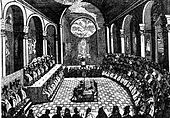
Back Tweede Konsilie van Nicea Afrikaans Segundo Concilio de Nicea AN مجمع نيقية الثاني Arabic مجمع نيقيه الثانى ARZ Conceyu de Nicea II AST Другі Нікейскі сабор Byelorussian Другі Нікейскі сабор BE-X-OLD Седми вселенски събор Bulgarian Drugi nikejski sabor BS Segon Concili de Nicea Catalan
This article needs additional citations for verification. (September 2017) |
| Second Council of Nicaea | |
|---|---|
 The Second Council of Nicaea, with Patriarch Tarasios (left of cross), Constantine VI (right of cross), seated bishops and a condemned iconoclast (below).[1] | |
| Date | 787 |
| Accepted by | |
Previous council |
|
Next council | |
| Convoked by | Constantine VI and Empress Irene (as regent) |
| President | Patriarch Tarasios of Constantinople, and legates of Pope Adrian I |
| Attendance | 308 bishops, 350 members total (including two papal legates) |
| Topics | Iconoclasm |
Documents and statements | Veneration of icons approved |
| Chronological list of ecumenical councils | |
| Part of a series on the |
| Eastern Orthodox Church |
|---|
| Overview |
| Part of a series on the |
| Ecumenical councils of the Catholic Church |
|---|
 |
| 4th–5th centuries |
| 6th–9th centuries |
| 12th–14th centuries |
| 15th–16th centuries |
| 19th–20th centuries |
|
|
The Second Council of Nicaea is recognized as the last of the first seven ecumenical councils by the Eastern Orthodox Church and the Roman Catholic Church. In addition, it is also recognized as such by Old Catholics and others. Protestant opinions on it are varied.
The Council assembled in 787 AD in Nicaea (site of the First Council of Nicaea; present-day İznik, Bursa, in Turkey), to restore the use and veneration of icons (or holy images),[2] which had been suppressed by imperial edict inside the Byzantine Empire during the reign of Leo III (717–741). His son, Constantine V (741–775), had held the Council of Hieria to make the suppression official.
The Council determined that the honorary veneration (timētikē proskynēsis) of icons was permitted, and that the true adoration (alēthinē latreia) was reserved for God alone. It further stated that the honor paid to the icon eventually passes over to the individual that it represents, thus, veneration of an icon could not be idolatrous as the iconoclasts believed. The iconodule position was not justified by Christological arguments (as in the Council of Hieria), rather, the antiquity of iconodulia and the Incarnation of Christ, which was said to make acceptable the depiction of Christ, were emphasized.[3][4]
- ^ Treadgold 1997, p. 420.
- ^ Gibbon, p. 1693.
- ^ Nicalaides 2014, p. 77.
- ^ Auzépy 2008, p. 288.